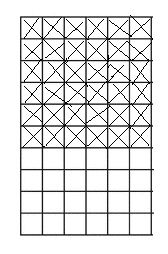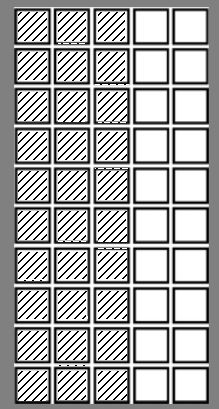
Figure 1
Districting Activity
Prepared by:
Joseph Malkevitch
Department of Mathematics
York College (CUNY)
Jamaica, New York 11451
email:
malkevitch@york.cuny.edu
web page:
http://york.cuny.edu/~malk
After a geographical region R (say a borough of a city) has been assigned a number of seats in a legislative body using some apportionment method, there is the problem of subdividing R into "election districts." Courts usually insist that in the interest of being fair, that these districts be equal in population and the shape of the districts be "nice" or "compact" rather than being chosen to achieve some political goal. The process of drawing districts for achieving a political goal has come to be called gerrymandering, which is characterized by the use of irregular and strangely shaped districts. The situation discussed below is very artificial but it supports lots of work in geometry classes with basic ideas about shape, area, congruence, perimeter, etc. We will assume there are exactly two parties competing for seats, the hatched (X's) party and the not-hatched (no X) party.
Suppose region R is a rectangle which consists of 60 1x1 unit squares. Each square represents one person who is either "marked with an X" or "not marketed with an X" (sort of like Republicans and Democrats). Sixty percent of the people are marked with an X in this district and 40 percent are not marked with an X Their geographical distribution is shown in Figure 1. When a district has more people of one type than the other, we will assume that this district will elect a representative of the majority type who live there. Thus, a district of size 10, with 6 marked with an X cells and 4 cells not marked with an X, will elect a marked with an X representative and a 10 cell district with no cells marked with an X cells will elect an unmarked with an X representative. Districts are to be drawn up which are "fair" or "gerrymandered" and which have shapes which are formed by pasting the individual squares together edge to edge but without "holes." Also, districts which are in separate pieces will not be permitted. Shapes that are formed in this way are called polyominoes. (Squares could meet at a vertex without sharing an edge but here this will not be permitted.) Figure 1 has 60 squares which means that it has lots of integer divisors, so one could have two districts with 30 people in each or 12 districts with 5 people each. If representation is proportional one would expect for 10 districts, 6 to elect a representative of the marked with an X kind, and 4 to elect a representative not with an X.

Question 1:
a. What different numbers of integer district sizes all of the same size are possible for Figure 1?
b. What districts of size 10 can you design whose shapes are congruent districts which elect different mixtures of with and without X's representatives? (Can one have all districts elect with an X representatives? All districts represented with no X representatives?
c. Repeat part b. for districts of other sizes for this district with 60 people.
d. If the location of where the marked with an X or not cells were distributed differently, would this affect what could be accomplished?
Question 2
Repeat the work for Figure 2 below where again 60 percent of the cells are marked with hatching (rather than an X) but here we have a 5x10 rectangle with 50 cells and a particular distribution of hatched and unhatched cells.

Question 3:
How might one define a measure of compactness for different shaped geometric regions into which a district might be subdivided (more general situation than above) as specified by decisions of the US Supreme Court? (For example, is a triangle with base 16 and altitude to that base of 1 more or less compact than a 1 x 8 rectangle? What about other shapes of area 8?